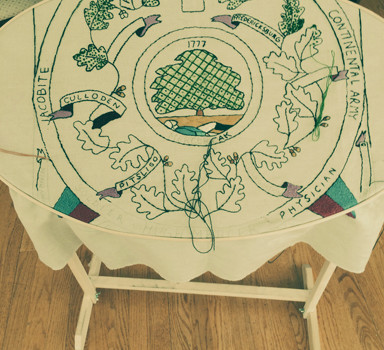Morven Remembers Hugh Mercer, In Scottish Diaspora Tapestry


MERCER COUNTY’S SCOTTISH CONNECTION: This winter, volunteer stitchers at Morven Museum and Garden worked on this panel paying tribute to General Hugh Mercer as part of the Scottish Diaspora Tapestry project. When completed, the finished panel, which has the famous Mercer Oak as its centerpiece, will be sent back to Scotland to join others like it celebrating the achievements and contributions of Scots around the world. (Image Courtesy of Morven Museum and Garden)
Morven Museum and Garden on Stockton Street is participating in a worldwide celebration of The Scottish Diaspora by bringing volunteer stitchers together to work on a single tapestry panel that is to be included in a larger work in tribute to the accomplishments of Scots around the world.
Princeton’s contribution features elements from the life of Revolutionary War hero General Hugh Mercer (1726-1777), who died a slow death over several days from bayonet wounds received at the hands of British soldiers during the Battle of Princeton.
After his horse had been shot from under him, Mercer was bayoneted repeatedly and left for dead. Legend has it that he lay under the famous oak tree that would become a symbol of the county named for him, before being taken to the William Clark house nearby.
But Mercer’s story goes back a long way before his friend George Washington, with whom he had fought in the French and Indian War, made him a brigadier general in the Continental Army.
Like many of his patriotic companions, Mercer had fled his native Scotland for the colony of America. As a battlefield surgeon at the Battle of Culloden in 1746, he had witnessed the bloody butchery that ended the Scottish attempt to restore the Stuarts to the British throne. Led by Charles Edward Stuart, the legendary Bonnie Prince Charlie, hopes for this Jacobite Rebellion were dashed at Drumossie Moor where the battle was fought, just north of Inverness.
Two years earlier, at the age of 19, and newly graduated from Aberdeen University, Mercer had been inspired by thoughts of replacing the German-speaking King George II with the prince that highlanders regarded as the rightful heir to the united monarchy of Scotland, England, and Ireland.
Centuries later, the name Culloden retains the power to evoke chills in the Scottish psyche and in a dramatic account of Mercer’s death in General Hugh Mercer: Forgotten Hero of the American Revolution, author Frederick English describes Mercer’s defiance of the British redcoats as a throwback to his days as a battlefield doctor. He would not ask for mercy of soldiers who called to him to surrender, calling him a “rebel.”
Morven’s contribution to the Scottish Diaspora Tapestry Project involved many hands. The Museum’s Barbara Webb commends “stalwart stitching volunteer” Alison Totten for the lion’s share of the work, helped also by Edie Tattersall during the recent holiday period.
The embroidered panel connects Princeton to two dozen other communities engaged in documenting their Scottish connections. The aim is to pay homage to emigrant Scots over the centuries by gathering and celebrating the stories of those individuals who had a profound impact on the areas where they settled.
“I hadn’t picked up a needle since the 1960s but knew this was something I could contribute to,” said Ms. Totten, who welcomed the opportunity to “honor all my Scottish ancestors, who represent a cross section of the Diaspora. I am part of the McLean clan of Argyll.”
According to the project’s organizers, Scots and their descendants “never lost a deeply held pride in Scotland’s culture and its democratic ideals: they took with them their religion, skills in medicine, engineering, botany, education, administration, agriculture, and more besides.”
“I saw a lot of people who, like me, had not done needlework in a long time, and who, like me, were taught by a mother or grandmother all those years ago,” said Ms. Totten who was quick to credit the skills of an accomplished embroiderer from the Embroidery Guild of America for stitching the Mercer Oak and the recumbent figure of Mercer under it. “It was a sheer delight to encourage them to put in a stitch or two and watch their faces transform with joy. We even got a few cub scouts to participate! One 4-year-old girl had to be pried away by a very patient mother.”
Soon to be shipped back to Scotland, Morven’s panel shows the Mercer Oak alongside the names of significant places in the life of the soldier physician. The international artwork of which it will form a part, is a successor to the first communal Scottish tapestry project, The Great Tapestry of Scotland, completed in 2013.
Hundreds of stitchers in 25 countries volunteered thousands of hours to craft panels which illustrate such contributions as the arrival of tea in India; the creation of a steelworks in Corby, England; military leadership in Sweden and Russia; national parks and tobacco growing in the United States; and the gold rush in Australia.
Mercer was one of Washington’s most trusted advisers. According to military historian and Washington biographer Douglas Southall Freeman, had Mercer lived, he “might have been [Washington’s] peer and possibly his superior.”
For more on the Morven project, visit: http://morven.org/the-scottish-diaspora-tapestry-project/. For more about the tapestry, visit: www.scottishdiasporatapestry.org.

